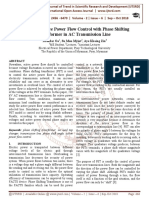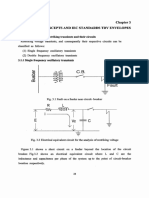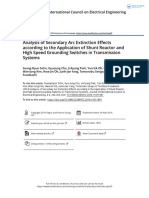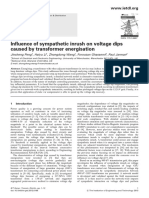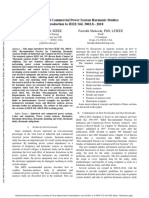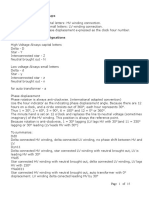Shunt Reactor
Shunt Reactor
Uploaded by
Kunik SwaroopCopyright:
Available Formats
Shunt Reactor
Shunt Reactor
Uploaded by
Kunik SwaroopOriginal Description:
Copyright
Available Formats
Share this document
Did you find this document useful?
Is this content inappropriate?
Copyright:
Available Formats
Shunt Reactor
Shunt Reactor
Uploaded by
Kunik SwaroopCopyright:
Available Formats
AM. S. Alboaijan Int.
Journal of Engineering Research and Applications
ISSN : 2248-9622, Vol. 4, Issue 9( Version 1), September 2014, pp.50-55
RESEARCH ARTICLE
www.ijera.com
OPEN ACCESS
Reactive Power Compensation and Control via Shunt Reactors
and Under Ground Power Cables
Abdulaziz M. S. Alboaijan
Electrical Power Department, High Institute of Energy, Public Authority of Applied Education and Training,
KUWAIT
ABSTRACT
In this paper we will cover the techniques used locally to accomplish the reactive power compensation. First, the
importance of reactive power compensation is explained through defining the different types of electrical power
and showing the effect of power compensation on the electric power network quality. The power under ground
cable is the first technique used to compensate for the inductance of overhead transmission lines and power
transformers during heavy loading of the network. Then, we explore the application of the two types of shunt
reactors in different locations of the network to compensate for the capacitance of the network during light
loading. Finally, a conclusion is presented.
Key words- compensation, reactive power, shunt reactor, under ground power cable.
I. INTRODUCTION
Reactive power has been recognized as an
important factor in the design and operation of
alternating current electric power systems. Since the
impedance of the network components are mainly
reactive, the transmission of active power requires a
difference in angular phase between the voltages at
the sending end and the receiving end. While the
transmission of reactive power requires a difference
in magnitude of these same voltages. Reactive power
is consumed not only by most of the network
elements , but also by most of the consumer loads.
The required reactive power must be supplied some
where and if we can not transmit it very easily then it
must be generated at the point where it is needed. The
reactive power must be supplied at the same voltage
of the load who requires it.
Reactive power compensation is defined as the
management of reactive power flow to improve the
performance of the power system. It is related to both
the system and customers. Generally we can look to
the reactive power compensation from two aspects:
load compensation and voltage support. In load
compensation the objectives are to increase the value
of the system power factor, to balance he real power
drawn from the supply, compensate voltage
regulation and to eliminate current harmonic
components produced by large and fluctuating non
linear industrial loads [1], [2]. While voltage support
is generally required to reduce voltage fluctuation at
a given point of the system.
Recently, reactive power compensation and
control acquired more importance for at least four
reasons :first, the huge demand on electrical power,
second, the need to increase transmission capacity as
www.ijera.com
much as possible; third, the development of variety of
controllable static compensators, and forth due to the
sharp increase of the fuel and crude oil needed for
electrical power generation. Some of the
consumption of reactive power is in the network
series elements themselves, for example, in overhead
transmission lines and power transformer leakage
reactance. Thus, a direct way of increasing power
transfer in power transmission systems, and of
reducing voltage drop, is to compensate part of the
series inductive reactance by series capacitors. Series
compensation reduces the series impedance of the
line which causes voltage drop and is the most
important factor in finding the maximum power
transfer [3]. Shunt compensation (parallel) for the
transmission line capacitance is also carried out
through connecting parallel inductors to absorb the
reactive power generated or injected by the line
capacitance.
II. THEORITICAL ASPECTS
The concept of active, reactive, and apparent
power plays a major role in electric power
technology. The terms active, reactive and apparent
power apply to steady-state sinusoidal alternating
current circuits. The apparent power S is expressed in
volt-amperes. Apparent power is independent of the
phase angle between voltage and current. While,
active power P is the real power or the true power
consumed by the load expressed in watts. Resistors
are considered active loads where the voltage and
current are in phase. Active power is dependent on
the cosine of the phase angle between the current
and the voltage and is composed of series of positive
power pulses as in Figure 1 .
50 | P a g e
AM. S. Alboaijan Int. Journal of Engineering Research and Applications
ISSN : 2248-9622, Vol. 4, Issue 9( Version 1), September 2014, pp.50-55
www.ijera.com
Figure 1. Instantaneous active power in a resistive load .
Capacitors and inductors are considered reactive
loads and reactive power Q is measured in VARS.
According to present AIEE convention volt-amperes
reactive are absorbed by inductive loads and Q for
inductive load is considered positive. While, voltamperes are supplied by capacitive loads and Q for
capacitive load is considered negative. Equipment on
the network that considered inductive loads are:
inductive reactance (XL), induction motors, welding
transformer, all inductive loads, series reactance, and
under excited synchronous motors. While, coactive
loads on the network are: shunt capacitors, series
capacitors, capacitance of transmission line, over-
excited synchronous condenser/motor, cables and
transmission lines on low loads [4].
For capacitors the current leads the voltage by 90
while for inductors the current lags the voltage also
by 90. Therefore, the current of the capacitor is 180
out of phase with the current of the inductor. Figure
2. shows the waveforms of the reactive power due to
connecting an inductor to an alternating source. The
reactive power is composed of series positive and
negative loops. The positive loops of the reactive
power are corresponding to the instantaneous power
delivered from the source to the inductor and the
negative loops represent the instantaneous power
delivered from the inductor to the source.
Figure 2. Instantaneous reactive power in an inductive load .
Figure 3. Instantaneous reactive power in a capacitive load .
The three types of power for single phase can be expressed as follows
S = I E*
P = I E COS
Q = I E SIN
The relation between these powers is expressed in (4) and shown in Fig. 4.
S = P jQ
www.ijera.com
(1)
(2)
(3)
(4)
51 | P a g e
AM. S. Alboaijan Int. Journal of Engineering Research and Applications
ISSN : 2248-9622, Vol. 4, Issue 9( Version 1), September 2014, pp.50-55
www.ijera.com
Figure 4. Phase representation of complex power for lagging power factor load
Figure 5. shows the distributed impedance of the
transmission line. The transmission line in general
can be represented by its lumped model as in Figure
6. The value of R, XL, and XC depends on the line
length and characteristics. The series inductance
reduces the line transfer capability and also results in
voltage drop. The series inductance absorbs reactive
power from the network and it must be supplied
through the generating power stations or supplied
locally. The shunt capacitance draws a charging
current or it injects reactive power to the network.
Therefore, a series capacitor is added to the
transmission line to supply the transmission line
inductance with the reactive power it needs and a
shunt inductance is added to the system to absorb the
reactive power injected by the shunt capacitance.
Figure 5. Distributed impedance of a transmission line.
Figure 6. Equivalent lumped model of a transmission line
III. COMPENSATION VIA POWER
UNDER GROUND CABLES
The capacitance of power under ground cables
is very high compared to that for the over head
transmission line and that's because of the small
distance between the different phases of the under
ground cable. Therefore the capacitive reactance of
under ground cables XC is very small compared to
that of over head transmission line. While, inductive
reactance of over head transmission line XL is large
compared to that of the under ground cable. For our
local network power under ground cables are
dominant and they are more than 40000 km in length
for different voltage levels. While overhead
www.ijera.com
transmission lines are just 9000 km. The effect of
under ground cables capacitance during light loading
of the network and the inductance of over head
transmission lines during heavy loading must be
considered. Table 1 shows a typical values of these
impedances [5].
Table 1. Typical impedance values per kilometer for
3-phase 60 Hz Lines
Type of Line
XL ()
XC ()
Over Head Transmission 0.5
300000
Line
Under Ground Cable
0.1
3000
52 | P a g e
AM. S. Alboaijan Int. Journal of Engineering Research and Applications
ISSN : 2248-9622, Vol. 4, Issue 9( Version 1), September 2014, pp.50-55
In our local electrical net work where the climate
is very hot during most of the year. The main
residential consumer loads are air conditioning with a
poor lagging power factor where a lot of reactive
power to be absorbed by these loads in addition to the
reactive power required by the inductance of the
overhead transmission lines and power transformers.
Therefore, the reactive power needed must be
generated through the power generating stations and
transmitted through the transmission and distribution
stages which would result in overheating and over
loading to the network components. Hence, the
reactive power generated locally for the consumer
loads ( residential or industrial ) by adding shunt
capacitance units in the premises of the consumers.
But for the reactive power required by power
transformers and over head transmission lines is
generated locally by under ground power cables.
Normally, for the security of the electrical network
and for the maintenance requirement there is at least
one extra under ground power cable between two
different electrical substations is available. These
under ground cables normally is opened from both
substations when they are not needed and connected
from both sides when needed. These under ground
cables if connected from on side only they will be
energized and works as a capacitor and injecting
reactive power to the net work. The reactive power
generated from each under ground power cable
depends on the voltage level and the cable length and
other specifications. Therefore, in summer time
where the net wok is very loaded and reactive power
is needed , these under ground cables are energized
by the national control center engineers and
according to the reactive power compensation needed
and at the place needed. Control engineer can chose
between the different power cables available
according to the reactive power they can inject to the
network to satisfy the requirements in terms of
reactive power and other variables of the network.
www.ijera.com
IV. COMPENSATION VIA SHUNT
REACTORS
Under light or no-load conditions , charging
current should be kept less than the rated full-load
current of the line. The charging current is
approximately given by BC |V| where BC is the total
capacitive susceptance of the line and |V| is the rated
voltage to neutral. If the total inductive susceptance is
Bl due to several inductors connected from line to
neutral at appropriate places along the line, then the
charging current can be expressed as in (5)
Ichg=( BC - Bl ) |V| = BC |V| ( 1 - Bl / BC )
Reduction of the charging current is by the factor
of
( 1 - Bl / BC ) and Bl / BC is the shunt
compensation factor. Shunt compensation at no-load
also keeps the receiving end voltage within limits.
Thus shunt reactors should be introduced as load is
removed for proper voltage control.
Shunt reactors used in our local network is
composed of two types. The first type is used with
conjunction of 300MVA power transformers used at
the voltage level of 300KV where the main windings
of the power transformer are step down
300KV/132KV and a third tertiary winding is added
as 33KV to be used as a shunt reactor absorbing
reactive power. The second type of shunt reactors are
just a three phase primary winding and is available at
different var ratings and at different voltage levels.
Therefore, var compensation is carried out in the
main and the interconnected substations using shunt
reactors and according to the voltage level.
On the 300/132 KV substations where 300 MVA
power transformers are used with three windings , the
tertiary winding voltage is 33 KV and used as a shunt
reactor of 45 MVAR a shown in Fig. 7.
Figure 7. Shunt reactor as a tertiary winding for 300 MVA power transformer
www.ijera.com
(5)
53 | P a g e
AM. S. Alboaijan Int. Journal of Engineering Research and Applications
ISSN : 2248-9622, Vol. 4, Issue 9( Version 1), September 2014, pp.50-55
www.ijera.com
For 300 KV long over head transmission lines a shunt reactor of 250 MVAR is installed as in Fig. 8 to
compensate for the shunt capacitance of the transmission line.
Figure 8. Shunt reactor installed for 300 KV over head transmission line .
For 132KV long over head transmission lines a
50MVAR shunt reactor is connected as shown in Fig.
9.
For 132/11 KV substations a shunt reactor is
installed as a feeder panel with a reactive power of 45
MVAR. While for 33/11 KV substations a shunt
reactor is installed as a feeder panel with a reactive
power of 35 MVAR.
Figure 9. Different shunt reactors at different locations of the network
V.
CONCLUSION
Reactive power compensation through the basic
methods shown in this paper even though they are
simple in terms of control but they are effective in
www.ijera.com
terms of reactive power compensation. Harmonics
resulting from thyristors used in control of modern
reactive power compensators are avoided.
54 | P a g e
AM. S. Alboaijan Int. Journal of Engineering Research and Applications
ISSN : 2248-9622, Vol. 4, Issue 9( Version 1), September 2014, pp.50-55
www.ijera.com
REFERENCES
[1]
[2]
[3]
[4]
[5]
T. J. Miller, Reactive power control in
electric systems( John Willey & Sons ,
1982).
E. Warnner, R. Mathys, M. Hausler,
Compensation systems for industry, Brown
Boveri Review, vol. 70, pp. 330-340,
Sept./Oct. 1983.
Kothari, D. P. and Nagrath, I. J., Modern
power system analysis (3rd Edition, Tata
McGraw-Hill, New Delhi, 2003).
SUNIL S. RAO, Switchgear protection and
power systems, (11th Edition, Romesh
Chander Khana for KHANA PUBLISHERS
Delhi, 1999.
Theodore
Wildi,
Electrical
power
technology (1st Edition, John Wiley and
Sons, New York, 1981).
www.ijera.com
55 | P a g e
You might also like
- Magnetically Controlled Electrical Reactors PDF100% (1)Magnetically Controlled Electrical Reactors PDF249 pages
- Phase-Shifting Transformer Control and Protection Settings VerificationNo ratings yetPhase-Shifting Transformer Control and Protection Settings Verification15 pages
- Magnetically Controlled Shunt Reactors - A New Type of FACTS DeviceNo ratings yetMagnetically Controlled Shunt Reactors - A New Type of FACTS Device3 pages
- Fault Contribution of Grid Connected InvertersNo ratings yetFault Contribution of Grid Connected Inverters5 pages
- Pre-Insertion Resistor of Switching Shunt Capacitor Banks: C L C LNo ratings yetPre-Insertion Resistor of Switching Shunt Capacitor Banks: C L C L7 pages
- Transients Caused by Switching of 420kV Shunt ReactorNo ratings yetTransients Caused by Switching of 420kV Shunt Reactor18 pages
- Non Optimum Compensation Schemes For Single Pole Reclosing On EHV Double Circuit TLNo ratings yetNon Optimum Compensation Schemes For Single Pole Reclosing On EHV Double Circuit TL9 pages
- 2GHV092716 en B Controlled Switching of High-Voltage Circuit-Breakers GTINo ratings yet2GHV092716 en B Controlled Switching of High-Voltage Circuit-Breakers GTI16 pages
- Metal Enclosed Switched Shunt Reactor BanksNo ratings yetMetal Enclosed Switched Shunt Reactor Banks13 pages
- User'S Manual, Accan Ac Circuit Analysis: O.W. AndersenNo ratings yetUser'S Manual, Accan Ac Circuit Analysis: O.W. Andersen22 pages
- Air Core Reactor Applications Current Limiting Reactors: UnrestrictedNo ratings yetAir Core Reactor Applications Current Limiting Reactors: Unrestricted24 pages
- Temporary Overvoltages Following Transformer EnergizingNo ratings yetTemporary Overvoltages Following Transformer Energizing3 pages
- 12 - 308 - 1998 Variable Mvar Output Shunt Reactors PDF100% (1)12 - 308 - 1998 Variable Mvar Output Shunt Reactors PDF12 pages
- Analysis of Active Power Flow Control With Phase Shifting Transformer in AC Transmission LineNo ratings yetAnalysis of Active Power Flow Control With Phase Shifting Transformer in AC Transmission Line7 pages
- Introduction To Electromagnetic Transient Analysis of Power SystemsNo ratings yetIntroduction To Electromagnetic Transient Analysis of Power Systems8 pages
- RL - AM-,WWY-: TRV Rating Concepts and Iec Standards TRV Envelopes100% (2)RL - AM-,WWY-: TRV Rating Concepts and Iec Standards TRV Envelopes17 pages
- Analysis of Secondary Arc Extinction Effects According To The Application of Shunt Reactor and High Speed Grounding Switches in Transmission SystemsNo ratings yetAnalysis of Secondary Arc Extinction Effects According To The Application of Shunt Reactor and High Speed Grounding Switches in Transmission Systems7 pages
- In A of Of: Failure Transformer of LevelsNo ratings yetIn A of Of: Failure Transformer of Levels9 pages
- Current Harmonic Analysis of Multi Pulse Diode Rectifiers With Phase Shifting TransformerNo ratings yetCurrent Harmonic Analysis of Multi Pulse Diode Rectifiers With Phase Shifting Transformer5 pages
- Influence of Sympathetic Inrush On Voltage DipsNo ratings yetInfluence of Sympathetic Inrush On Voltage Dips12 pages
- Design and Analysis of Transformer Using MATLABNo ratings yetDesign and Analysis of Transformer Using MATLAB6 pages
- Ferroresonant Configurations in Power Systems: V. Valverde, G. Buigues, A. J. Mazón, I. Zamora, I. Albizu100% (1)Ferroresonant Configurations in Power Systems: V. Valverde, G. Buigues, A. J. Mazón, I. Zamora, I. Albizu6 pages
- Calculate Effective and Low-Impedance Grounding For Power Systems - Technical ArticlesNo ratings yetCalculate Effective and Low-Impedance Grounding For Power Systems - Technical Articles6 pages
- Ferroresonance at Open Phase Operating Conditions100% (1)Ferroresonance at Open Phase Operating Conditions4 pages
- Industrial and Commercial Power System Harmonic Studies - Introduction To IEEE Std. 3002.8 - 2018No ratings yetIndustrial and Commercial Power System Harmonic Studies - Introduction To IEEE Std. 3002.8 - 201811 pages
- Application of Numerical Relays For HV Shunt Reactor ProtectionNo ratings yetApplication of Numerical Relays For HV Shunt Reactor Protection5 pages
- Gult-TS1-GTS1 - Sheath Voltage Cal - 2016!07!10No ratings yetGult-TS1-GTS1 - Sheath Voltage Cal - 2016!07!1031 pages
- PAPER 2003 03 en HV Shunt Reactor Secrets For Protection EngineersNo ratings yetPAPER 2003 03 en HV Shunt Reactor Secrets For Protection Engineers30 pages
- Controlled Switching Technique For Minimization of Switching Surge ScienceNo ratings yetControlled Switching Technique For Minimization of Switching Surge Science13 pages
- Differences Between Shunt Reactor and Power Transformer - EEPNo ratings yetDifferences Between Shunt Reactor and Power Transformer - EEP5 pages
- Grid-Integrated and Standalone Photovoltaic Distributed Generation Systems: Analysis, Design, and ControlFrom EverandGrid-Integrated and Standalone Photovoltaic Distributed Generation Systems: Analysis, Design, and ControlNo ratings yet
- Dear Parents, Please Find Below The Academic Schedule For Your ReferenceNo ratings yetDear Parents, Please Find Below The Academic Schedule For Your Reference2 pages
- Best Energy Practices For Remote FacilitiesNo ratings yetBest Energy Practices For Remote Facilities59 pages
- Transformer Acceptance Tests and Final InspectionsNo ratings yetTransformer Acceptance Tests and Final Inspections18 pages
- Electronics and Communication Engineering: Section 1: NetworksNo ratings yetElectronics and Communication Engineering: Section 1: Networks4 pages
- Cathode Ray Oscilloscope (Cro) : Electronic InstrumentationNo ratings yetCathode Ray Oscilloscope (Cro) : Electronic Instrumentation34 pages
- Rev 1 - FONA ART Plus Operator Manual GB PDFNo ratings yetRev 1 - FONA ART Plus Operator Manual GB PDF32 pages
- Automatic Railway Gate Controller Project Report71% (7)Automatic Railway Gate Controller Project Report32 pages
- Am/Fm 1 Chip Radio S1A0427B01: VCC 4.5V 6.0V 7.5V 9.0V Line Operated RNo ratings yetAm/Fm 1 Chip Radio S1A0427B01: VCC 4.5V 6.0V 7.5V 9.0V Line Operated R15 pages
- 6se3190 0XX87 8BF0 Opm Clear Text Display Siemens ManualNo ratings yet6se3190 0XX87 8BF0 Opm Clear Text Display Siemens Manual76 pages
- Thermography Report of PFIC (Points Above 70 Deg) : SL No. Pfic HarmonicNo ratings yetThermography Report of PFIC (Points Above 70 Deg) : SL No. Pfic Harmonic17 pages
- Diffuse Sensors With Background SuppressionNo ratings yetDiffuse Sensors With Background Suppression1 page
- SRNE ASF-series 48V 8-10kW Split-Phase Solar-Charger-Inverter Usermanual 1.4100% (1)SRNE ASF-series 48V 8-10kW Split-Phase Solar-Charger-Inverter Usermanual 1.441 pages
- M. Lampara de Fotocurado Woodpecker Led-E-InglesNo ratings yetM. Lampara de Fotocurado Woodpecker Led-E-Ingles15 pages
- 3COM OS Switch 4500 V3.03.02p15 Release NotesNo ratings yet3COM OS Switch 4500 V3.03.02p15 Release Notes74 pages
- Catalogue - LG Air-Cooled Scroll Chiller - 220.380.460V100% (1)Catalogue - LG Air-Cooled Scroll Chiller - 220.380.460V42 pages
- 90W Smps For Monitors With Constant Power Limiting Function: AN1133 Application NoteNo ratings yet90W Smps For Monitors With Constant Power Limiting Function: AN1133 Application Note11 pages
- KL09033 NCVT 2 Dual Range Non Contact Voltage Tester InstructionsNo ratings yetKL09033 NCVT 2 Dual Range Non Contact Voltage Tester Instructions5 pages
- Rule: Airworthiness Directives: Garmin AT, Inc. Mooney M20M and M20R AirplanesNo ratings yetRule: Airworthiness Directives: Garmin AT, Inc. Mooney M20M and M20R Airplanes3 pages
- 10.introduction To Data-Parallel ArchitecturesNo ratings yet10.introduction To Data-Parallel Architectures21 pages
- Phase-Shifting Transformer Control and Protection Settings VerificationPhase-Shifting Transformer Control and Protection Settings Verification
- Magnetically Controlled Shunt Reactors - A New Type of FACTS DeviceMagnetically Controlled Shunt Reactors - A New Type of FACTS Device
- Pre-Insertion Resistor of Switching Shunt Capacitor Banks: C L C LPre-Insertion Resistor of Switching Shunt Capacitor Banks: C L C L
- Transients Caused by Switching of 420kV Shunt ReactorTransients Caused by Switching of 420kV Shunt Reactor
- Non Optimum Compensation Schemes For Single Pole Reclosing On EHV Double Circuit TLNon Optimum Compensation Schemes For Single Pole Reclosing On EHV Double Circuit TL
- 2GHV092716 en B Controlled Switching of High-Voltage Circuit-Breakers GTI2GHV092716 en B Controlled Switching of High-Voltage Circuit-Breakers GTI
- User'S Manual, Accan Ac Circuit Analysis: O.W. AndersenUser'S Manual, Accan Ac Circuit Analysis: O.W. Andersen
- Air Core Reactor Applications Current Limiting Reactors: UnrestrictedAir Core Reactor Applications Current Limiting Reactors: Unrestricted
- Temporary Overvoltages Following Transformer EnergizingTemporary Overvoltages Following Transformer Energizing
- 12 - 308 - 1998 Variable Mvar Output Shunt Reactors PDF12 - 308 - 1998 Variable Mvar Output Shunt Reactors PDF
- Analysis of Active Power Flow Control With Phase Shifting Transformer in AC Transmission LineAnalysis of Active Power Flow Control With Phase Shifting Transformer in AC Transmission Line
- Introduction To Electromagnetic Transient Analysis of Power SystemsIntroduction To Electromagnetic Transient Analysis of Power Systems
- RL - AM-,WWY-: TRV Rating Concepts and Iec Standards TRV EnvelopesRL - AM-,WWY-: TRV Rating Concepts and Iec Standards TRV Envelopes
- Analysis of Secondary Arc Extinction Effects According To The Application of Shunt Reactor and High Speed Grounding Switches in Transmission SystemsAnalysis of Secondary Arc Extinction Effects According To The Application of Shunt Reactor and High Speed Grounding Switches in Transmission Systems
- Current Harmonic Analysis of Multi Pulse Diode Rectifiers With Phase Shifting TransformerCurrent Harmonic Analysis of Multi Pulse Diode Rectifiers With Phase Shifting Transformer
- Ferroresonant Configurations in Power Systems: V. Valverde, G. Buigues, A. J. Mazón, I. Zamora, I. AlbizuFerroresonant Configurations in Power Systems: V. Valverde, G. Buigues, A. J. Mazón, I. Zamora, I. Albizu
- Calculate Effective and Low-Impedance Grounding For Power Systems - Technical ArticlesCalculate Effective and Low-Impedance Grounding For Power Systems - Technical Articles
- Industrial and Commercial Power System Harmonic Studies - Introduction To IEEE Std. 3002.8 - 2018Industrial and Commercial Power System Harmonic Studies - Introduction To IEEE Std. 3002.8 - 2018
- Application of Numerical Relays For HV Shunt Reactor ProtectionApplication of Numerical Relays For HV Shunt Reactor Protection
- PAPER 2003 03 en HV Shunt Reactor Secrets For Protection EngineersPAPER 2003 03 en HV Shunt Reactor Secrets For Protection Engineers
- Controlled Switching Technique For Minimization of Switching Surge ScienceControlled Switching Technique For Minimization of Switching Surge Science
- Differences Between Shunt Reactor and Power Transformer - EEPDifferences Between Shunt Reactor and Power Transformer - EEP
- Power System Wide-area Stability Analysis and ControlFrom EverandPower System Wide-area Stability Analysis and Control
- Computer Methods in Power Systems Analysis with MATLABFrom EverandComputer Methods in Power Systems Analysis with MATLAB
- Grid-Integrated and Standalone Photovoltaic Distributed Generation Systems: Analysis, Design, and ControlFrom EverandGrid-Integrated and Standalone Photovoltaic Distributed Generation Systems: Analysis, Design, and Control
- Dear Parents, Please Find Below The Academic Schedule For Your ReferenceDear Parents, Please Find Below The Academic Schedule For Your Reference
- Transformer Acceptance Tests and Final InspectionsTransformer Acceptance Tests and Final Inspections
- Electronics and Communication Engineering: Section 1: NetworksElectronics and Communication Engineering: Section 1: Networks
- Cathode Ray Oscilloscope (Cro) : Electronic InstrumentationCathode Ray Oscilloscope (Cro) : Electronic Instrumentation
- Am/Fm 1 Chip Radio S1A0427B01: VCC 4.5V 6.0V 7.5V 9.0V Line Operated RAm/Fm 1 Chip Radio S1A0427B01: VCC 4.5V 6.0V 7.5V 9.0V Line Operated R
- 6se3190 0XX87 8BF0 Opm Clear Text Display Siemens Manual6se3190 0XX87 8BF0 Opm Clear Text Display Siemens Manual
- Thermography Report of PFIC (Points Above 70 Deg) : SL No. Pfic HarmonicThermography Report of PFIC (Points Above 70 Deg) : SL No. Pfic Harmonic
- SRNE ASF-series 48V 8-10kW Split-Phase Solar-Charger-Inverter Usermanual 1.4SRNE ASF-series 48V 8-10kW Split-Phase Solar-Charger-Inverter Usermanual 1.4
- Catalogue - LG Air-Cooled Scroll Chiller - 220.380.460VCatalogue - LG Air-Cooled Scroll Chiller - 220.380.460V
- 90W Smps For Monitors With Constant Power Limiting Function: AN1133 Application Note90W Smps For Monitors With Constant Power Limiting Function: AN1133 Application Note
- KL09033 NCVT 2 Dual Range Non Contact Voltage Tester InstructionsKL09033 NCVT 2 Dual Range Non Contact Voltage Tester Instructions
- Rule: Airworthiness Directives: Garmin AT, Inc. Mooney M20M and M20R AirplanesRule: Airworthiness Directives: Garmin AT, Inc. Mooney M20M and M20R Airplanes
























